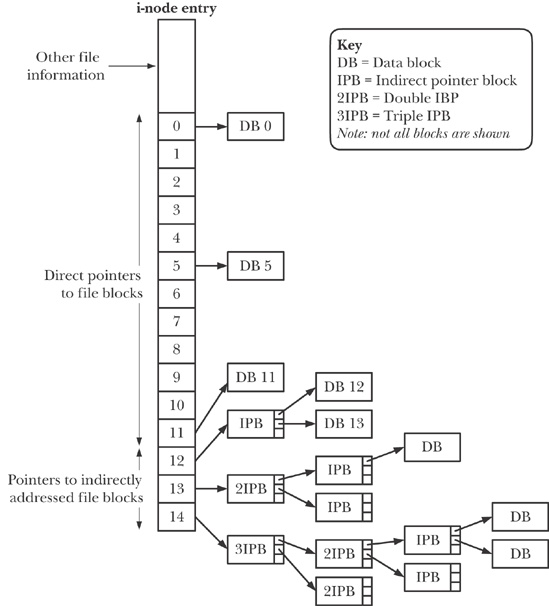A file system’s i-node table contains one i-node (short for index node) for each file residing in the file system. I-nodes are identified numerically by their sequential location in the i-node table. The i-node number (or simply i-number) of a file is the first field displayed by the ls -li command. The information maintained in an i-node includes the following:
File type (e.g., regular file, directory, symbolic link, character device).
Owner (also referred to as the user ID or UID) for the file.
Group (also referred to as the group ID or GID) for the file.
Access permissions for three categories of user: owner (sometimes referred to as user), group, and other (the rest of the world). File Permissions provides further details.
Three timestamps: time of last access to the file (shown by ls -lu), time of last modification of the file (the default time shown by ls -l), and time of last status change (last change to i-node information, shown by ls -lc). As on other UNIX implementations, it is notable that most Linux file systems don’t record the creation time of a file.
Number of hard links to the file.
Size of the file in bytes.
Number of blocks actually allocated to the file, measured in units of 512-byte blocks. There may not be a simple correspondence between this number and the size of the file in bytes, since a file can contain holes (Changing the File Offset: lseek()), and thus require fewer allocated blocks than would be expected according to its nominal size in bytes.
Pointers to the data blocks of the file.
Like most UNIX file systems, the ext2 file system doesn’t store the data blocks of a file contiguously or even in sequential order (though it does attempt to store them close to one another). To locate the file data blocks, the kernel maintains a set of pointers in the i-node. The system used for doing this on the ext2 file system is shown in Figure 14-2.
Note
Removing the need to store the blocks of a file contiguously allows the file system to use space in an efficient way. In particular, it reduces the incidence of fragmentation of free disk space—the wastage created by the existence of numerous pieces of noncontiguous free space, all of which are too small to use. Put conversely, we could say that the advantage of efficiently using the free disk space is paid for by fragmenting files in the filled disk space.
Under ext2, each i-node contains 15 pointers. The first 12 of these pointers (numbered 0 to 11 in Figure 14-2) point to the location in the file system of the first 12 blocks of the file. The next pointer is a pointer to a block of pointers that give the locations of the thirteenth and subsequent data blocks of the file. The number of pointers in this block depends on the block size of the file system. Each pointer requires 4 bytes, so there may be from 256 pointers (for a 1024-byte block size) to 1024 pointers (for a 4096-byte block size). This allows for quite large files. For even larger files, the fourteenth pointer (numbered 13 in the diagram) is a double indirect pointer—it points to blocks of pointers that in turn point to blocks of pointers that in turn point to data blocks of the file. And should the need for a truly enormous file arise, there is a further level of indirection: the last pointer in the i-node is a triple-indirect pointer.
This seemingly complex system is designed to satisfy a number of requirements. To begin with, it allows the i-node structure to be a fixed size, while at the same time allowing for files of an arbitrary size. Additionally, it allows the file system to store the blocks of a file noncontiguously, while also allowing the data to be accessed randomly via lseek(); the kernel just needs to calculate which pointer(s) to follow. Finally, for small files, which form the overwhelming majority of files on most systems, this scheme allows the file data blocks to be accessed rapidly via the direct pointers of the i-node.
Note
As an example, the author measured one system containing somewhat more than 150,000 files. Just over 30% of the files were less than 1000 bytes in size, and 80% occupied 10,000 bytes or less. Assuming a 1024-byte block size, all of the latter files could be referenced using just the 12 direct pointers, which can refer to blocks containing a total of 12,288 bytes. Using a 4096-byte block size, this limit rises to 49,152 bytes (95% of the files on the system fell under that limit).
This design also allows for enormous file sizes; for a block size of 4096 bytes, the theoretical largest file size is slightly more than 1024*1024*1024*4096, or approximately 4 terabytes (4096 GB). (We say slightly more because of the blocks pointed to by the direct, indirect, and double indirect pointers. These are insignificant compared to the range that can be pointed to by the triple indirect pointer.)
One other benefit conferred by this design is that files can have holes, as described in Section 4.7. Rather than allocate blocks of null bytes for the holes in a file, the file system can just mark (with the value 0) appropriate pointers in the i-node and in the indirect pointer blocks to indicate that they don’t refer to actual disk blocks.
